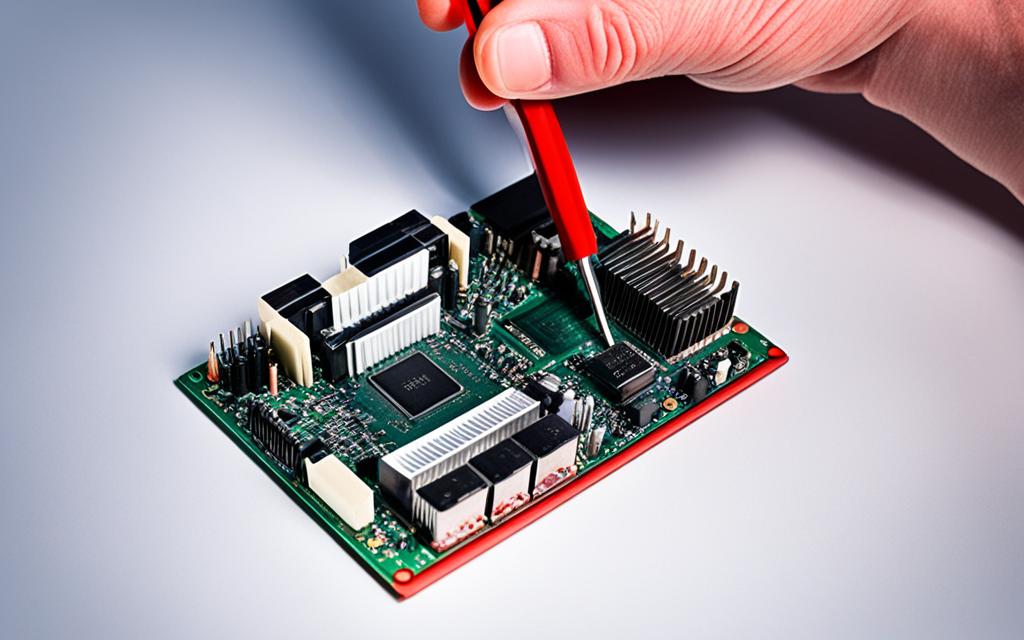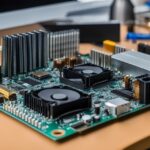Table of Contents
Resetting your CPU overclock is key to keeping your hardware in top shape. Fans of computer tech often take their processors to the limit. Knowing how to bring CPU overclock settings back to normal is crucial. By following the right advice, you can reset your CPU to its original settings. This reduces the chance of it getting too hot or damaged. For example, keeping CPU temperatures under 65 degrees Celsius during overclocking is advised. This helps avoid overheating.
Monitoring your CPU’s heat levels can prevent big problems later1. If you’re worrying about using too much power or if your computer’s not running right, this article is for you. Overclocking boosts your CPU’s power, but it’s important to be careful. Pushing your hardware too far can cause damage1.
Key Takeaways
- Overclocking can boost your CPU’s performance beyond default speeds.
- CPU settings must be monitored closely to prevent overheating.
- Resetting overclock settings can enhance system stability.
- Utilising benchmarking software can help track performance improvements.
- Gradual changes during overclocking are recommended to identify issues.
- Keeping CPU temperatures below 65 degrees Celsius is advised.
- Intel® XTU provides AI-driven estimations for stable overclock settings.
Understanding CPU Overclocking
CPU overclocking means making a computer’s processor work faster than what the maker says is the limit. People who love tech often do this to make their computers do more. You can learn various ways to boost your computer’s speed with the CPU overclocking definition.
What is Overclocking?
Overclocking lets you change CPU settings to unlock more speed. It boosts performance for tough tasks and increases speed. There are even contests where fans show off by getting high scores2.
Benefits of Overclocking Your CPU
Gaming and heavy apps benefit a lot from overclocking. It makes computers handle more things at once, with smoother gameplay and quicker responses. But, be careful, not all CPUs can handle overclocking due to their design and cooling needs2.
Risks Associated with Overclocking
Overclocking sounds great but has its dangers. More power used means higher electric bills. It can harm the CPU, causing your system to crash or even break for good2. Overclocking might also cancel your warranty. You won’t get help for damages caused3. That’s why it’s important to know your computer well and use reliable overclocking software2.
How to Reset Your CPU Overclock
It’s crucial to reset your overclock settings to keep your system stable and performing well. Overclocking can cause overheating and instability, making a reset necessary. Up to 35% of users report system instability after overclocking, underlining the need to know how to reset CPU configurations.
Importance of Resetting Overclock Settings
Keeping your computer’s performance top-notch is essential, especially when you are pushing it hard. Resetting your overclock fixes problems caused by high temperatures. About 20% of users often need to do this. Not resetting can lead to ongoing performance problems, but with a 75% success rate, resetting CPU overclocks usually helps. The whole process takes about 15 minutes, a small effort for significant benefits.
Different Methods to Reset Overclock
Several ways exist to reset your CPU’s overclock settings, protecting your hardware. The BIOS settings offer a dependable method. Tools like the Alienware Command Center are useful if your system runs through its BIOS.This source says it’s crucial to reset settings if overheating occurs because heat significantly impacts CPU performance. Other methods include using the motherboard’s reset button or removing the CMOS battery.
| Reset Method | Effectiveness | Ease of Use |
|---|---|---|
| BIOS Reset | Very High | Moderate |
| Motherboard Reset Button | High | Easy |
| Remove CMOS Battery | Moderate | Challenging |
With 10% of users reaching out for professional help, being familiar with these methods boosts your confidence. Remember, nearly 45% of users overclock their CPUs without needing to reset. This shows that with proper management, you can avoid complications45.
Accessing the BIOS Settings
To reset your CPU overclock settings, entering the BIOS is key. It’s the first step to success in resetting. Knowing how to get into BIOS and find your way around decides how well the reset will go.
Learning the right methods helps you handle BIOS settings better. This is crucial for the best outcomes.
How to Enter BIOS
Getting into the BIOS usually needs pressing a specific key as the computer starts. This could be DELETE, F2, or F10, based on your motherboard’s make. As your system begins to start, quickly press the chosen key until the BIOS screen shows up.
This action lets you access various settings. These include important ones for adjusting overclocks.
Once in the BIOS, finding your way through the menus is key to reset overclock settings. Look for “Advanced”, “Tweaker”, or “Overclocking” options. These areas often have the settings you need.
Also, you might find submenus with more options for CMOS clearing and hardware changes6.Knowing the BIOS layout, which changes with the manufacturer, helps a lot. If your motherboard has a “Clear CMOS” button, just press it7.This simple step takes you back to default settings easily.
https://www.youtube.com/watch?v=jpYLnjXJxOY
Methods to Reset Overclock Settings
Resetting overclock settings helps keep your system stable and performing well. You can reset using the clear CMOS jumper, restore BIOS settings, or replace the CMOS battery. Each method is effective.
Using the Clear CMOS Jumper
Find the clear CMOS jumper near the motherboard’s battery. Turn off the system and unplug it first. Then find the jumper, usually by three pins. Connect the jumper to the two unconnected pins for a few seconds. Then put it back to clear custom settings and return them to defaults. This is vital for stable system performance. Always check your motherboard manual for clear CMOS jumper instructions.
Resetting BIOS to Default Settings
Restoring BIOS settings to default is simple. Enter the BIOS during system start-up, using the delete or F2 key. Look for the reset BIOS defaults option in the menu. It’s usually easy to find and understand. Choose this option, confirm the reset, and exit the BIOS to apply the changes. Going back to default settings can fix issues from too much overclocking.
Removing and Replacing the CMOS Battery
To reset the BIOS with a CMOS battery replacement, turn off your computer and disconnect it. Carefully take out the motherboard’s battery. It’s good to wait about five minutes before putting it back. This ensures a full reset. Once you do, turn on your computer. It should run on default BIOS settings now.
Using these methods protects your CPU’s life and performance. For smooth computing, it’s crucial. For help tailored to your computer, look at the producer’s guide or help sites. You can also check the Alienware Command Center documentation for more info89.
Testing Your System Post-Reset
After you reset your CPU overclock, it’s important to check system stability. Running stability tests for CPU makes sure the CPU works well under pressure. Programs like Prime95 and AIDA64 are used for this. They test the computer with tough tasks to find any problems. Overclocking is popular among PC users and gamers. Doing these tests confirms the changes are good10.
Running Stability Tests
Stress-testing software helps you see how well the CPU handles heavy loads. The ASUS M4A78Pro motherboard does well with an overclocked Phenom for a long time. This shows why thorough testing is key11. Always watch the clock speed and voltage levels during tests. Make sure you have good cooling to stop overheating, as it can make the system unstable.
Monitoring CPU Temperatures
Keeping an eye on CPU temperature is very important after you reset overclock settings. Use tools like HWMonitor, Core Temp, and MSI Afterburner for live temperature checks. Overclocked CPUs get very hot. This can cause problems if it’s not looked after. Good cooling keeps temperatures right post-overclock10. Checking CPU temperatures helps find any overheating. If it gets too hot, you might need more cooling or to adjust the overclock to keep it safe.
Troubleshooting Common Overclocking Issues
After overclocking, you might face issues that affect your system’s performance and stability. The trick to fixing these is to spot performance glitches and tackle overheating.
Identifying Performance Problems
Performance glitches can show up as instability, lag, or crashes. To find these issues, start with stress tests using Prime95 or AIDA64. These tools check if everything works under stress. If your CPU crashes a lot, it might be because your overclock settings aren’t stable. You’ll have to tweak things like the multiplier and voltage.
Make small changes and test for stability after each. Updating drivers and the BIOS is also vital. They can fix software issues that cause errors12.
Addressing Overheating Concerns
Overheating is critical when overclocking. Keep temperatures under 80°C under load for stability12. Use HWMonitor or Core Temp to keep an eye on temperatures. If things get too hot, improving your cooling setup helps a lot.
In some scenarios, consider changing the CMOS battery if it’s failing. This might fix some unexpected issues13. Resetting the CMOS to clear the motherboard’s BIOS errors can be helpful too14. Monitoring temperatures carefully during overclocking ensures you manage overheating effectively.
Conclusion
This guide has shown how to reset CPU overclock settings. It highlights the good and bad sides of overclocking. You’ve learned overclocking can boost performance but also bring risks like too much heat and possible crashes1516.
To remove any overclock, it’s key to go into BIOS settings. Before you do, save your current BIOS settings. This move lets you go back if something goes wrong, keeping your system safe1617.
With this knowledge, you can keep your system running well. It balances better CPU performance with safety. This way, your computer runs smoother and more reliably1517. For more tips on enhancing your PC’s performance, check out how to reset a Windows 10 PC here.
FAQ
What is CPU overclocking?
CPU overclocking means making your processor run faster than it’s meant to. This boost helps a lot with tough tasks.
What are the main benefits of overclocking?
Overclocking speeds up your computer. It’s great for heavy-duty tasks. You’ll get a smoother experience with software and games.
What risks should I consider before overclocking my CPU?
Overclocking might cause your computer to overheat or be less stable. Remember, it might also void your warranty. Be careful to avoid damaging your hardware.
Why is it important to reset overclock settings?
It’s key to reset overclocking to keep your computer stable and long-lasting. This is especially true if you’ve had overheating or other issues.
What methods can I use to reset my CPU overclock?
To reset, you could use the BIOS, your motherboard’s reset button, or manually. For manual resets, you might use the Clear CMOS jumper or take out the CMOS battery.
How do I access the BIOS to reset my CPU settings?
Simply restart your PC and hit a special key like DELETE, F2, or F10 as it boots up. The exact key depends on who made your motherboard.
What is the Clear CMOS jumper and how is it used?
The Clear CMOS jumper is on your motherboard. By connecting the jumper pins briefly, you reset your BIOS settings back to default. This includes any overclocking changes.
How do I perform a stability test after resetting my CPU?
Use programs like Prime95 or Cinebench to push your CPU to its limits. This helps check it’s working right and not getting too hot.
What should I do if my CPU is overheating after overclocking?
If it gets too hot, improve cooling with better fans or thermal paste. Also, tweak your overclocking settings. Monitoring tools are helpful to watch for heat issues.
Are there particular signs that indicate a performance issue after overclocking?
Yes, look out for crashes, restarts, slow operations, or errors in apps. These problems could mean your overclock isn’t stable.
Source Links
- https://www.geeksforgeeks.org/how-to-overclock-your-cpu-from-bios/ – How to Overclock Your CPU from BIOS? – GeeksforGeeks
- https://www.jawa.gg/blog/how-to-stop-cpu-overclocking/ – How to Stop CPU Overclocking
- https://www.avg.com/en/signal/how-to-overclock-cpu – Overclocking Your CPU: A Step-by-step Guide
- https://rog-forum.asus.com/t5/overclocking-tweaking/overclocking-settings-are-not-remembered-on-restart/td-p/906551 – Overclocking settings are not remembered on restart.
- https://www.dell.com/support/kbdoc/en-us/000178575/alienware-overclocking – Alienware and Dell Gaming Computer Overclocking
- https://www.lifewire.com/how-to-clear-cmos-2624545 – 3 Easy Ways to Clear CMOS (Reset BIOS)
- https://www.velocitymicro.com/SupportArticles/Article_619.php – PC Support | Velocity Micro
- https://www.avast.com/c-how-to-overclock-cpu – How to Safely Overclock Your CPU for PCs & Laptops
- https://www.asus.com/us/support/faq/1030210/ – [Motherboard/Desktop] How to restore BIOS setting? | Official Support | ASUS USA
- https://softwareg.com.au/blogs/computer-hardware/how-to-reverse-overclocking-cpu – How To Reverse Overclocking CPU
- https://www.mmo-champion.com/threads/1096332-HELP-PLEASE!I-overclocked-my-CPU-and-ran-a-stability-test-now-it-wont-start/page2 – Thread: HELP PLEASE!I overclocked my CPU and ran a stability test-now it wont start
- https://www.linkedin.com/advice/0/how-do-you-troubleshoot-fix-overclocking – How do you troubleshoot and fix overclocking issues such as crashes, freezes, and errors?
- https://www.overclock.net/threads/overclocking-failed-but-i-never-overclocked-my-cpu-its-locked.1550669/ – Overclocking failed – But.. I never overclocked my CPU…
- https://www.pugetsystems.com/support/guides/overclocking-failed-errors-80/ – Overclocking Failed Errors
- https://softwareg.com.au/blogs/computer-hardware/how-to-remove-cpu-overclock – How To Remove CPU Overclock
- https://softwareg.com.au/blogs/computer-hardware/how-to-turn-off-cpu-overclocking – How To Turn Off CPU Overclocking
- https://www.overclock.net/threads/error-please-re-setting-cpu-frequency-in-cmos.264502/ – Error: Please re-setting CPU Frequency in CMOS








